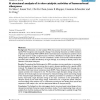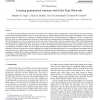262 search results - page 38 / 53 » Protein secondary structure prediction using neural networks |
ISMB
1994
13 years 9 months ago
1994
In this paper, westudy the application of an ttMM(hidden Markov model) to the problem of representing protein sequencesby a stochastic motif. Astochastic protein motif represents ...
BMCBI
2007
13 years 7 months ago
2007
Background: Ribozymes are small catalytic RNAs that possess the dual functions of sequencespecific RNA recognition and site-specific cleavage. Trans-cleaving ribozymes can inhibit...
NN
2007
Springer
13 years 7 months ago
2007
Springer
Echo State Networks (ESNs) have been shown to be effective for a number of tasks, including motor control, dynamic time series prediction, and memorizing musical sequences. Howeve...
DNA
2007
Springer
14 years 2 months ago
2007
Springer
Abstract. A major challenge in nanoscience is the design of synthetic molecular devices that run autonomously and are programmable. DNA-based synthetic molecular devices have the a...
ICANN
2001
Springer
14 years 9 days ago
2001
Springer
We distinguish between two main types of model: predictive and explanatory. It is argued (in the absence of models that predict on unseen data) that in order for a model to increas...


